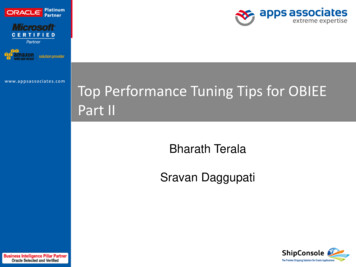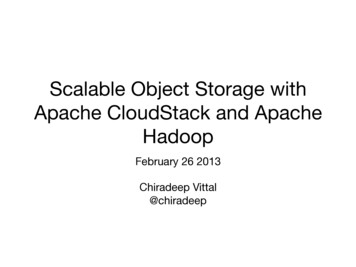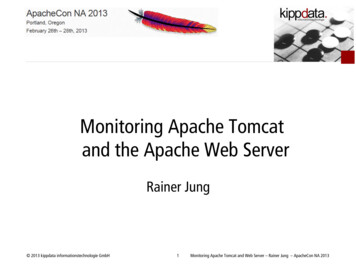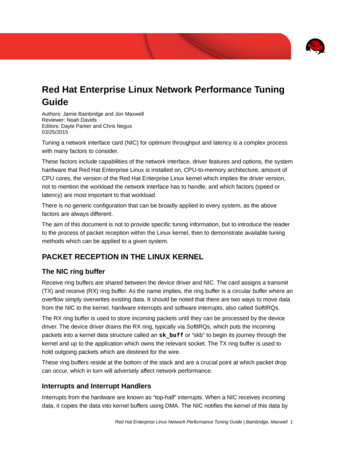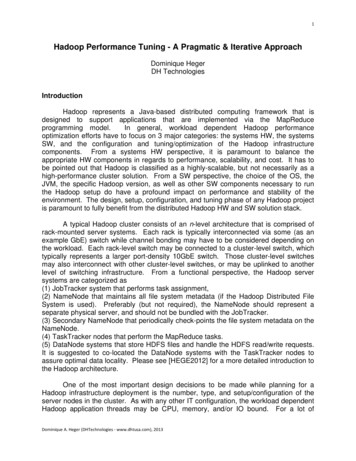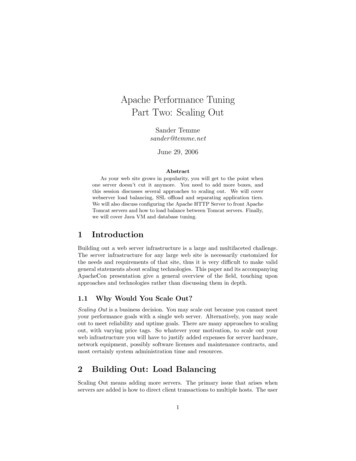
Transcription
Apache Performance TuningPart Two: Scaling OutSander Temmesander@temme.netJune 29, 2006AbstractAs your web site grows in popularity, you will get to the point whenone server doesn’t cut it anymore. You need to add more boxes, andthis session discusses several approaches to scaling out. We will coverwebserver load balancing, SSL offload and separating application tiers.We will also discuss configuring the Apache HTTP Server to front ApacheTomcat servers and how to load balance between Tomcat servers. Finally,we will cover Java VM and database tuning.1IntroductionBuilding out a web server infrastructure is a large and multifaceted challenge.The server infrastructure for any large web site is necessarily customized forthe needs and requirements of that site, thus it is very difficult to make validgeneral statements about scaling technologies. This paper and its accompanyingApacheCon presentation give a general overview of the field, touching uponapproaches and technologies rather than discussing them in depth.1.1Why Would You Scale Out?Scaling Out is a business decision. You may scale out because you cannot meetyour performance goals with a single web server. Alternatively, you may scaleout to meet reliability and uptime goals. There are many approaches to scalingout, with varying price tags. So whatever your motivation, to scale out yourweb infrastructure you will have to justify added expenses for server hardware,network equipment, possibly software licenses and maintenance contracts, andmost certainly system administration time and resources.2Building Out: Load BalancingScaling Out means adding more servers. The primary issue that arises whenservers are added is how to direct client transactions to multiple hosts. The user1
does not know and does not need to know that multiple servers are in use. Theyjust want to point their browser to www.example.com and spend a lot of moneyon your products or services. In this section we will review several techniquesto distribute client transactions across your hosts.2.1Load Balancing with DNSYou have a great deal of control over where your users direct their transactionsby using the Domain Name Service (DNS) for your site. This seems obvious,but it is critical to scaling. When your users connect to www.example.com,they don’t care to which IP address this resolves. If you can manipulate thisresolution, you can send the user to whichever physical server you prefer, whichcan be of great benefit to the infrastructure2.1.1Distinct Servers for Distinct ServicesOne way to distribute transaction load across multiple physical servers is to giveeach server a separate task. For your www.example.com site, use an images.example.com server to serve static image content, a secure.example.com serverto handle SSL transactions, etc. This approach allows you to tune each serverfor its specialized task. The downside is that this approach does not scale byitself: once, for instance, your secure server runs out of processing headroom,you will have to add more machines using one of the techniques described below.2.1.2DNS Round-RobinIf you operate multiple servers that perform identical functions, you can distribute client transactions among them using Domain Name Server RoundRobin. The principle behind this technique is that a single server hostnameresolves to a different IP address from your server pool for each DNS resolutionrequest. For instance, if you have three web servers with the IP addresses10.11.0.11310.11.0.11410.11.0.115and you have your name server return each of those addresses in turn forqueries to your web server name (www.scalingout.org), roughly one third ofall clients will connect to each of your web servers. Since popular name serverimplementations like bind implement this technique by default, it is very simpleto implement without any resource requirements besides control over your DNSzone.How “roughly” this works depends on many factors, over few of which youhave any control. Client-side resolvers cache query reponses, as do intermediatenameservers at ISPs and corporations. Large ISPs and corporations representmany potential users, all of whom would be directed to the same web server foras long as their nameserver caches the original lookup. However, across your2
Server 1NLB EnabledThe InternetSwitchServer 2ManagementHeartbeatNetworkSwitchServer 3Figure 1: The Network Load Balancing feature is included in Windows ServerSystem. It clusters servers as peers, using a separate network connection forload balancing decision and heartbeat traffic.entire user population these discrepancies may even out. You can help thisprocess by reducing the cache timeout for query results in your zone file. Anexample zone file that uses DNS Round-Robin is shown in Appendix A.DNS Round-Robin as a load balancing approach is often disparaged becauseof its simplicity: it does not take into account the load on the servers, andcan not compensate for server outage. If a server goes down for any reason,one third of all clients will still be directed to the nonfunctional server. If theseconsiderations are important to you, consider one of the more sophisticated loadbalancing approaches described below. However, do not dismiss DNS RoundRobin out of hand. Depending on your requirements, it may be all you need.2.2Peer-based Load BalancingYou can turn a collection of individual servers into a cluster by using loadbalancing techniques. In this section we will discuss Microsoft’s approach.2.2.1Windows Network Load BalancingWindows Load Balancing Service (WLBS) technology has been available sinceWindows NT Server 4.0, Enterprise Edition and is now included in WindowsServer 2003 under the name Network Load Balancing (NLB). Using NetworkLoad Balancing, you can turn up to 32 servers into a cluster. The service workby having every machine assume the same IP address, and the same MAC address, on the clustered interface(s). Incoming connections arrive at all membersof the cluster simultaneously from the network switch. The NLB software communicates between cluster members over a unicast or multicast backchanneland is responsible for the load balancing decisions. It sits between the network3
10.0.0.2Web Server 1The Internet192.0.34.16610.0.0.1Load BalancerGET /index.html HTTP/1.1Host: www.example.comX-Forwarded-For: 24.5.108.15110.0.0.3Web Server 210.0.0.424.5.108.151Web Server 3GET /index.html HTTP/1.1Laptop Host: www.example.comFigure 2: A Load Balancer Appliance forwards incoming requests to one of theweb serverscard driver and the TCP/IP stack, and regulates which cluster member gets toanswer each incoming request. Cluster members whose NLB module doesn’tcommunicate with the other members get removed from the pool. This allowsNLB to provide High Availability as well as load balancing functionality.Because it operates below the TCP/IP layer, Network Load Balancing shouldbe compatible with any service that runs on the server machines. Each clustermember has to be configured exactly the same. Please see your Windows Server2003 documentation for details.2.3Load Balancing ApplianceThe market for dedicated load balancing appliances is now quite crowded, withofferings from vendors like Cisco, F5, Juniper, Foundry and many others vyingfor your attention. These products can be pricy, but are powerful solutions forload balancing your server farm.2.3.1How a Load Balancer WorksLoad balancing appliances or application switches sit between the web serversand the outbound network connection and intelligently distribute traffic acrossmultiple web servers. They typically keep track of the load and availability of theservers, and adjust their load balancing decisions accordingly. Many of theseproducts can operate on several layers of the network stack and can inspectincoming requests to make load balancing decisions based on source address,requested URI, cookies submitted etc.4
2.3.2Linux Virtual ServerThe Linux Virtual Server project is an open source load balancing and highavailability implementation. Its core module, IP Virtual Server, is included inthe kernel as of version 2.6.10. Auxiliary software like ipvsadm is only an installaway. If you are considering rolling your own load balancing solution, considerLinux Virtual Server.The primary disadvantage of Linux Virtual Server is that it does not comeas a nice, shiny plug-and-play box with a support contract. Instead, it looksmore like an Erector Set1 of bits and pieces that you get to integrate yourself.However, this disadvantage can also be a strength: it allows you to build asolution that best fits your needs. However, the absence of a 24x7 support planmay upset your decision makers. You can find an example configuration forLinux Virtual Server in Appendix B.2.4Load Balancing with TomcatThe Tomcat application server and its mod jk Apache HTTP Server connectorprovide load balancing functionality that allows running a number of Tomcatinstances behind a single web server.This approach to Scaling Out is important for both performance and reliability reasons. On the performance side, the web server can distribute resourceintensive application traffic among multiple application servers. From a reliability point of view, it becomes possible to selectively take down Tomcat instancesfor maintenance, without affecting overall availability of your application. Or,you can periodically stop-start Tomcat instances to prevent the build up of issues like memory leaks. Additionally, in the event a Tomcat instance crashes,the load balancing mod jk worker will automatically take it out of the pool untilit becomes available again.The load balancing functionality in mod jk uses a round-robin algorithm toassign requests to its workers. It maintains sticky sessions based on the Tomcatsession cookies, so requests that belong to the same application session willalways be routed to the same Tomcat instance.A complete example of a Tomcat/mod jk load balancing configuration isavailable in Appendix C. You can also load balance a number of Tomcat serversusing the mod proxy balancer module that comes with Apache 2.2. This approach is discussed in Section 2.5.2.4.1Session Replication in a Tomcat ClusterSticky sessions allow for session persistence across a load balancer by having italways route traffic that carries a specific session cookie to the same back-endTomcat server. However, when one of the backj-end servers crashes or is takenout of service for maintenance, the sessions it is serving at that moment are lost.This is highy undesirable if these sessions represent customers’ shopping carts1 Perhapsbetter known in Europe as Meccano.5
or banking transactions. Tomcat clustering and session replication preventssession loss by copying session information from any cluster member to all theother members as soon as a session is created.Clustering works over IP multicast. There are specific requirements for theenvironment and session objects, which must be serializable. These requirements are discussed in the Tomcat documentation2 . An example configurationis discussed in Appendix C.2.5Load Balancing with Apache 2.2Version 2.2 of the Apache HTTP Server includes a load balancing proxy module,mod proxy balancer. This add-on to mod proxy can balance incoming requestsbetween multiple back-end servers. It can persist connections to a particularback-end based on a configurable Cookie key like JSESSIONID or PHPSESSIONID.The configuration looks as follows:Listen 80LogLevel debugTransferLog logs/access logLoadModule proxy module modules/mod proxy.soLoadModule proxy http module modules/mod proxy http.soLoadModule proxy balancer module modules/mod proxy balancer.soProxyPass / balancer://mycluster/ProxyPassReverse / http://localhost:16180ProxyPassReverse / http://localhost:16280 Proxy balancer://mycluster BalancerMember http://1.2.3.4:80BalancerMember http://1.2.3.5:80 /Proxy The configuration above will equally distribute requests between two backend web servers. If your back-end servers are running Tomcat, you can enablesticky sessions as follows:. Proxy balancer://tccluster BalancerMember http://localhost:15180 route tc1BalancerMember http://localhost:15280 route tc2BalancerMember http://localhost:15380 route tc3 /Proxy Location / ProxyPass balancer://tccluster/ stickysession JSESSIONIDRequire all granted /Location The server.xml file of each Tomcat server has to be edited to include ajvmRoute attribute in the Engine element. For instance, in the first Tomcat,you have:2 /tomcat-docs/cluster-howto.htmlon a default Tomcat installation6
!-- . -- Server port "15105" shutdown "SHUTDOWN" !-- . -- Service name "Catalina" Connector port "15180" maxHttpHeaderSize "8192"maxThreads "150" minSpareThreads "25" maxSpareThreads "75"enableLookups "false" redirectPort "8443" acceptCount "100"connectionTimeout "20000" disableUploadTimeout "true" / !-- . -- Engine name "Catalina" defaultHost "localhost" jvmRoute "tc1" !-- . -- /Engine /Service /Server The mod proxy balancer module also contains a small management application, which you can enable using the following configuration snippet: Location /balancer-manager SetHandler balancer-manager# Your access control directives hereOrder Allow,denyAllow from all# . /Location The management feature requires the presence of mod status in additionto mod proxy balancer. As you can see, the load balancing reverse proxy inApache HTTP Server 2.2 is quite easy to set up. For more information aboutthe configuration options, please see the mod proxy documentation3 . Moreinformation on the algorithms for the load balancing decision can be found inthe mod proxy balancer documentation4 .3Building Out: Separate TiersMost web applications can be separated into multiple distinct tiers:1. Web server tier(Apache, IIS, Sun ONE)2. Application server tier (Tomcat, PHP, WebLogic, etc.)3. Database server tier (MySQL, Oracle, Postgres, etc.)Every tier has distinct and particular performance requirements. Movingeach tier to their own hardware allows you to tune and scale them individually.The fact that all of the individual applications communicate with each otherover TCP/IP already makes this move even easier.3 http://httpd.apache.org/docs/2.2/mod/mod4 lproxy balancer.html
NetworkSwitchNetworkSwitchThe gure 3: When you divide your application functionality into multiple tiers,you can scale out by adjusting each tier for maximum performance, independentof the other tiers.3.1The Web Server TierThe Web Server tier communicates directly with the users. It is responsible formaintaining connection with a wide variety of client browsers across potentiallyslow and far-flung connections. This causes a markedly different load on theoperating system TCP stack than the long-lived, local, high speed connectionsbetween web and application server, and between application server and thedatabase. The web tier can also be configured to serve the application’s staticcontent: HTML pages, images, JavaScript, etc. It passes only the requests fordynamically generated content (PHP scripts, JavaServer Pages, RSS feeds) onto the application tier. The type of server used for this tier typically has one ortwo CPUs and enough memory to fit the requisite number of httpd processes.Storage is not a concern.3.2The Application Server TierThe Application Server tier generates all dynamic content. It receives requests from the web tier and maintains connections to the database tier. Theoperating system can be tuned specifically to run an application server platform such as a Java virtual machine. The type of server used for this tier mayhave multiple CPUs as required to run application threads. These servers havemore memory than the web servers as required by the application platform, butstorage is not important on this tier.3.3The Database Server TierThe Database Server tier stores all application data. The application servertier connects to the database tier using the JDBC protocol or native databaselibraries. Database access can be a considerable bottleneck for application performance, so performance is an important consideration for this tier. The typeof server used for this tier should have sufficient CPU power and RAM to run thedatabase application, and come with scalable, redundant storage like a RAID-5array.8
44.1Designing Your Site for Scaling OutDesigning for a Load BalancerA Load Balancer introduces an additional moving part to your web server infrastructure. While most load balancer solutions do their best to appear transparent to the application, you may find some issues that you can solve by properlydesigning your application.The main issue arises with session persistence. The HTTP protocol is inherently stateless, which is great for a load balancer: it can consider each incomingrequest for itself and make a completely independent load balancing decisionbased on its criteria. Session persistence potentially complicates this issue, especially if a user’s session exists only on the server that initially created it. If asubsequent request from that user is directed to a different back-end server, thesession is lost. Most load balancing solutions solve this problem by consistentlydirecting requests from a particular IP address to the same back-end server.Some can inspect incoming HTTP requests and make load balancing decisionsbased on session cookies.These load balancer based fixes should be enough under most circumstances,but your requirements may be more stringent: what if the user reconnects afterhis lunch break and the load balancer has timed out because of inactivity fromthe user’s IP address? Or the user reconnects from a different IP address (let’ssay she leaves one Starbucks and reconnects from the one across the street)?Or the server that holds the user’s session goes offline because of a crash ormaintenance? If it is important to you to maintain user sessions under circumstances like these, you should build session persistence into your application.Users sessions are likely to cause more reads than writes. You could write session information to your backend database, or use a special, fast database witha write-through cache just for session maintenance.5ConclusionScaling out your web site is a mixed blessing. While you get to serve moretransactions and, presumably, do more business, the additional hardware, software and network segments will also give you more intricacies to oversee. Youget to manage, maintain en secure a farm of servers instead of just one. Theconfiguration of your servers, and application software and content design willbe highly influenced by the infrastructure design decisions you make, and theywill be heavily intertwined. However, with judicious planning, scaling out canbe an efficient and effective solution to increased site demands.9
ADNS Round-Robin Zone FileThe following is a very basic DNS Zone file that uses Round-Robin DNS tobalance three web servers.scalingout.org. 864002006051401864007200864000086400 )scalingout.org.gwbagheeraIN SOA ns.scalingout.org. sctemme.scalingout.org. (; Serial; refresh (1 day); retry (2 hours); expire (10 days); minimum (1 NAAA10.11.0.11310.11.0.11410.11.0.115; .BLinux Virtual Server ConfigurationThis example uses a Linux Virtual Server director running Ubuntu 5.10 (TheBreezy Badger). The outside interface of the Director has IP address 10.0.0.1,its inside interface is on 192.168.1.1. Two back-end web servers are connectedto an internal interface of the Director. Their Ethernet interfaces are configuredfor 192.168.1.2 and 192.168.1.3 respectively, and both have 192.168.1.1 for default gateway. On the Director machine, the file /etc/ipvsadm.rules has thefollowing information:# ipvsadm.rules-A -t 10.0.0.1:80 -s rr-
Tomcat servers and how to load balance between Tomcat servers. Finally, we will cover Java VM and database tuning. 1 Introduction Building out a web server infrastructure is a large and multifaceted challenge. . On the

